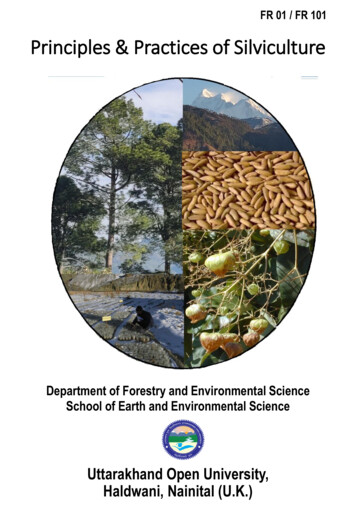
Transcription
FR 01 / FR 101Principles & Practices of SilvicultureDepartment of Forestry and Environmental ScienceSchool of Earth and Environmental ScienceUttarakhand Open University,Haldwani, Nainital (U.K.)
FR 01 / FR 101Principles & Practices of SilvicultureDepartment of Forestry and Environmental ScienceSchool of Earth and Environmental ScienceUttarakhand Open UniversityHaldwani 263139 , Nainital (U.K.)फोन: 05946-261122; फै क् स: 05946-264232;टौल फ्री : 18001804025 (प्रात:10 बजे से शाम 5 बजे तक सभी कार्यदिवसों में)वेबसाइट: http://www.uou.ac.in; इ-मेल: info@uou.ac.in
Board of StudiesProf. Jeetram, Department of Forestry and Environmental Science,Kumaun University, Nainital (U.K.)Prof. P.C. Joshi, Department of Zoology and Environmental Science,Gurukul Kangri, University, Haridwar (U.K.)Dr. Sachi Sah, Department of Environmental ScienceIndira Gandhi Open University, New DelhiProf. P.D. Pant, Director,School of Earth and Environmental Science, Uttarakhand Open University, Haldwani (U.K.)Dr. H.C. Joshi, Department of Forestry and Environemntal Science, SoEES, Haldani, Nainital (U.K.)Unit Writer: H.C. JoshiEditorial TeamProfessor Anil Kumar YadavDepartment of Forestry and Environmental Science, SSJ Campus, Almora (U.K.)Dr. CS DhanaiDepartment of Forestry, College of Forestry, Ranichauri, Tehri Garwal (U.K.)Cover page Design and Format EditingH.C. JoshiTITLEISBNCopyrightPublicationFirst EditionPrinciples and Practices of SilvicultureUttarakhand Open UniversityUttarakhand Open UniversityMay, 2020
Table of ContentsUnit 1: Introduction to Forest, Forestry and Silviculture1.0 Learning Objectives1.2 Introduction1.3 Forest and forestry1.4 Importance of Forests1.5 History of Forestry Development in India1.6 Forests of World and India1.7 SilvicultureSummaryUnit 2: Factors of Locality I - Atmosphere and Climate2.0 Introduction2.1 Learning Objectives2.2 Factors of Locality2.3 Climatic factors (Atmosphere and Climate)SummaryUnit 3: Factors of Locality II: Topographic, Edaphic and Biotic Factors3.0 Introduction3.1 Learning Objectives3.2 Topographic Factors3.3 Edaphic factors3.4 Biotic FactorsSummaryUnit 4: The Tree and the Forests: Germination, Growth and Development4.0 Introduction4.1 Learning Objectives4.2 The Trees and the Forests4.3 Seed Germination4.4 Growth and development in treesSummaryUnit 5 Forest Regeneration: Natural regeneration5.0 Introduction5.1 Learning Objectives5.2 Forest Regeneration- Concept and Definition5.3 Methods of Regeneration5.4 Natural regeneration5.5 NR from seed under various silvicultural systems5.5 Assisting natural regeneration (ANR)SummaryUnit 6 Forest Regeneration: Artificial Regeneration I6.0 Introduction6.1 Learning Objectives6.2. Artificial regeneration and its objectives6.3 Preliminary activities before artificial 66869698187919596969797104108109112113113114
6.4 Seed collection, extraction, drying and storage6.5 Artificial regeneration by seed sowingSummaryUnit 7 Forest Regeneration: Artificial Regeneration II7.0 Introduction7.1 Learning Objectives7.2 Common activities at plantation site during AR7.3 Artificial vs. natural regeneration7.4 Pure vs. mixed crops7.5 Kinds and patterns of mixtures7.6 ExoticsSummaryUnit 8: Tending operations- Intermediate cuttings8.0 Introduction8.1 Learning Objectives8.2 Concept and definitions8.3 Need of tending operations and time of application8.4 Types of tending operationsUnit 9: Silvicultural Systems I9.0 Introduction9.1 Learning Objectives9.2 Silvicultural Systems9.3 Clear felling System9.4. The Shelterwood or Uniform System9.5 Modifications in shelter wood systemSummaryUnit 10: Silvicultural Systems II10.0 Introduction10.1 Learning Objectives10.2 Selection System10.3 The Coppice system10.4 The Coppice with Standards System (Stored Coppice)10.5 Choice of silvicultural systemSummaryUnit 11: Silviculture of Indian Conifers I11.0 Introduction11.1 Learning Objectives11.2 Silviculture of Silver Fir11.3 Silviculture of DeodarSummaryUnit 12: Silviculture of Important Indian Conifers II12.0 Introduction12.1 Learning Objectives12.2 Silvicultural of Chirpine12.3 Silvicultural of Chilgoza 195199197197200206210210211217221
Unit 13: Silviculture of some important Indian Broadleaved Trees-I13.0 Introduction13.1 Learning Objectives13.2 Silviculture of Teak (Sagaun)13.3 Silviculture of Sal13.4 Silviculture of Shisham13.5 Silviculture of Alder13.6 Silviculture of EucalyptusUnit 14: Silviculture of some broad leaved trees II14.0 Introduction14.1 Learning Objectives14.2 Silviculture of Arjun14.3 Silviculture of Chandan14.4 Silviculture of Neem14.5 Silviculture of Bamboos14.6 66
PRINCIPLES AND PRACTICES OF SILVICULTUREFR 01Unit 1: Introduction to Forest, Forestry andSilvicultureUnit Structure1.0 Learning Objectives1.2 Introduction1.3 Forest and Forestry1.3.1 Definition of Forest1.3.2 Definition of Forestry1.3.3 Branches of forestry and their interrelationship1.3.4 Classification of Forest1.4 Importance of Forests1.4.1 Direct roles of forests1.4.2 Indirect roles of forests1.5 History of Forestry Development in India1.5.1 National Forest Policy -18941.5.2 National Forest Policy-19521.5.3 National Forest Policy-19881.5.4 Van Mahotsawa1.6 Forests of World and India1.7 Silviculture1.7.1 Definition1.7.2 Relationship of Silviculture and other branches of forestry1.7.4 Aims and objectives of silvicultural practices1.7.5 Source of silvicultural knowhow and scope of silvicultureSummaryReferences1.0 Learning ObjectivesAfter completing this unit you shall be able to: Define forest, forestry and silviculture Know the classification of forests and forestry Appreciate Forests in India and Describe the history of development of forestry in India1
PRINCIPLES AND PRACTICES OF SILVICULTUREFR 011.2 IntroductionForests are the resources which render many services to the humans throughout the globe.They not only help in regulating the streams, winds but also provide wood (the most widelyused material) and food in the form of wild edibles. Forests are essential for the well-beingof humankind. The object of forestry is mainly to get the best services from the forests notonly for the present generation but also to the future generations. Thus, forestry means theuses as well as preservation of the forest. Thus, basically forestry is the growing of trees asa crop which can be cut and used. The true concept of forestry is that of devoting landpermanently to forest production. Successive crops of trees are grown upon the same landand these crops are either cut clean and replanted or are made to reproduce themselvesnaturally by seeds or sprouts.In this unit we will be acquainted with various terms related with forestry and with the practiceof forestry. We will also learn about importance and uses of forests, historical developmentsin forestry, our national forest policies, and forests of India and world. At last we will alsounderstand the definition and concepts of silviculture.1.3 Forest and Forestry1.3.1 Definition of ForestThe word forest is derived from the Latin word 'foris’ which means ‘outside’. Originally,forest meant simply wild or uncultivated land regardless of cover. The Indian word 'jungle'has been adopted in the English language to describe a collection of trees, shrubs, etc.,which are not grown in a regular manner, as contrast with 'forest', which is any vegetationunder a systematic management [1]. Forest has been defined by various scientists andorganizations differently. These definitions are as follows:According to American Society of Foresters, a forest is “A plant association predominantlyof trees or other woody vegetation occupying an extensive area of land” [2].According to another definition, “An area set aside for the production of timber and otherforest produce, or maintained under woody vegetation for certain indirect benefits which itprovides, e.g., climatic or protective” [1].2
PRINCIPLES AND PRACTICES OF SILVICULTUREFR 01In simple words, it is “A plant community predominantly of trees and other woody vegetation,usually with a closed canopy”. Or “An area of land proclaimed to be a forest under a forestlaw” [1].There are great variations in the definitions of “Forest” which varies from place to place,region to region and one country to another country. It mainly depends upon the objectivesof management, land use, vegetation type, composition and altitude, etc.The definition of the word “forest” is not reflected in major conservation Acts of India, i.eIndian Forest Act, 1927, and Forest Conservation Act, 1980. However, the word ‘Forest’ and“Forest land” were defined by Hon’ble Supreme Court of India. According to the court theword “forest” must be understood according to its dictionary meaning. This descriptioncovers all kinds of forests which are recognized in the law i.e., reserve, protected or othercategories as mentioned in Section 2(i) of the Forest Conservation Act 1980. Further, theterm "forest land" has its mention in Section 2 of the Forest Conservation Act (1980) andincludes "forest" as understood in the dictionary meaning as well as any other area recordedas forest in the Governmental records irrespective of its ownership [3]. As mentioned in theScheduled Tribes and Other Traditional Forest Dwellers (Recognition of Forest Right Act2006), “Forest land” means land of any description falling within any area and includesunclassified forests, un-demarcated forests, existing or deemed forests, protected forests,reserved forests, Sanctuaries and National parks.Our country has redefined forests after Kyoto Protocol as, “A forest is a land area of atleast 0.05 ha, with a minimum tree crown cover of 15%, and tree height of at least 2m”. Whereas as per the India State of Forest Report 2011, Forest Area means the arearecorded as “Forest‟ in government records and the term “Forest Cover” includes “all landswith more than 1 ha area with more than 10% tree canopy density irrespective of theirlegal status and species composition [4].Food and Agriculture Organization (FAO) defines the term “Forest” as the Land having treesof more than 5 meters spread in over 0.5 hectares and with more than 10 per cent canopy cover,or trees able to reach these thresholds in situ [5]. It does not include land falling mainly underagricultural or urban land use. International Union of Forest Research Organizations (IUFRO)defines ‘forest’ as a land area with a minimum of 10% tree crown coverage (or equivalent3
PRINCIPLES AND PRACTICES OF SILVICULTUREFR 01stocking level), or formerly having such tree cover and that is being naturally or artificiallyregenerated or that is being afforested. As per European Commission, a forestland isdefined as having at least 20% canopy closure (10% in the Mediterranean forests) and aminimum area of 0.5 ha.1.3.2 Definition of ForestryThe term “Forestry” is defined as, ”thescience,artandpracticeofunderstanding, managing and usingwiselythenaturalresourcesassociated with, and derived fromforestlandsAs per Food and Agriculture Organization (FAO)2015, the term “Forest” has been defined as “Landspanning more than 0.5 hectares with trees higherthan 5 meters and a canopy cover of more than10 per cent, or trees able to reach thesethresholds in situ. It does not include land that ispredominantly under agricultural or urban formation/what-is-forestry/).According to University of MarylandExtension [7], Forestry is the scienceof tending woodlands.Canadian Forest Service (Glossary ofForestry Terms) defines Forestry as,“The science, art and practice ofmanaging trees and forests and theirassociated resources for humanChanges in SAF Definition of Forestry[12]The science and art of managing forests incontinuity for forest purposes, i.e., for woodsupplies and forest influences (1916)The scientific management of forests for thecontinuous production of goods andservices (1944, 1958).The science, the art, and the practice ofmanaging and using for human benefit thenatural resources that occur on and inassociation with forest lands (1967)benefit.The science, art and business of creating,managing, and conservingForestry may thus be defined as,forests and associated resources in asustainable manner to meet desired goals,needs, and values — note the broad field offorestry consists of those biological,quantitative, managerial, and socialsciences that are applied to forestmanagement and conservation; it includesspecialized fields such as agroforestry,urban forestry, industrial forestry andinternational forestry (Adopted by IUFRO2000).“Forestry is the theory and practice ofall that constitutes the creation,conservationandscientificmanagement of forests and theutilization of their resources toprovide for the continuous production4
PRINCIPLES AND PRACTICES OF SILVICULTUREFR 01of the required goods and services [1].1.3.3 Branches of forestry and their interrelationshipForestry has five different branches:1. Silviculture: If refers to certain aspects of theory and practices of raising forests crops,methods of raising tree crops, their growth and after care up to the time of final harvesting.2. Forest Mensuration: It refers to the determination of dimensions, form, volume, age andincrements of the logs, single trees, stands or whole woods.3. Silviculture system: Process by which the crops constituting a forest are tended, removaland replaced by new crops4. Management: Practical application of sequence technique and economics to forest estatefor the production of certain desired results5. Utilization: Branch of forestry which deals with harvesting, marketing conservation andapplying the forest produce to a variety of uses eg. Timber, fuel, charcoal, pulp wood, plywood.Another way of classifying forestry is on the basis of aims or objectives and may be of thefollowing type:1. Protection of Environmental Forestry: Protection of land, regulation of water cycle,Wild life conservation Modernization of climate conditions, combination of above.2. Commercial or Production Forestry: Timber and other raw materials.3. Social Forestry: Raising forests outside the traditional forest with the involvement ofsociety. Various forms of Social Forestry are:i) Community Forestry: The practice of forestry on lands outside the conventionalforest area for the benefit of local population has been called Community forestry.Community forestry seeks the involvement of community in the creation andmanagement of such forests. Thus it is raising of forests of public or communityland5
PRINCIPLES AND PRACTICES OF SILVICULTUREFR 01ii) Farm Forestry: Farm Forestry is defined as the practice of forestry in all itsaspect on farms of village lands generally integrated with other farm operations.It is raising forest trees on farms lands. It is further classified as:a) Non commercial farm forestry: raising of trees by individuals for domesticneeds (usually by the farmers)b) Commercial farms forestry: Farmers grow trees on commercial basis onfarmlands.iii) Extension Forestry: Extension forestry which includes the activity of raisingtrees on farm lands, villages wastelands and community forest areas and onlands along the sides of roads, canal banks and railway lines (Anon., 1976). Morerecently, there has been emphasis on dynamic land use planning and efforts aremade to maximise production on farmlands under agroforestry.iv) Agro-Forestry: Agro-forestry has been defined as a sustainable landmanagement system which increases the yield of the land, combines theproduction of crops and forest plants and/or animals simultaneously orsequentially on the same unit of land and applies management practices that arecompatible with the cultural practices of the local population.v) Recreational Forestry: More recently, there has been considerable demand forrecreational forestry, which is defined as the practice of forestry with the object ofdeveloping and maintaining forests of high scenic value. Recreational forests arebeing developed near towns and cities. The areas are being planted withflowering trees, shrubs and creepers to provide forest atmosphere near townsand cities.1.3.4 Classification of ForestForests are classified in different ways.A) Classification according to origin of forestThe forests may have their origin either from seeds or from sprouts arising from coppice cut.Accordingly forests are classified as:i) High forest: forest originated from seeds6
PRINCIPLES AND PRACTICES OF SILVICULTUREFR 01ii) Coppice forests: forest originated vegetative from suckers or sprouts from stumpB) Based on species composition- pure vs mixed cropPure forest is defined as, “a forest composed of almost entirely of one species, usually tothe extent of not less than 80%.” It is also called pure crop or pure stand.Mixed forest is defined as, “a forest composed of trees of two or more species nitermingledin the same canopy; in practice, and by convention, at least 20% of the canopy must consistsof species other than the principal ones”.Another terms used are ‘virgin forests’ and ‘second growth’. The former term refers toexpress the original state of natural forest where cutting has never taken place, whereaslater is used to express the crop that has come up in an area after harvesting or logging ofolder crop.According to National Forest Policy of 1952, four (04) categories of forests were identifiedbased on their functions. These are as follows:1. Protection Forests: Those forests which must be preserved or created for physical andclimatic considerations.2. National Forests: Those forests which have to be maintained and managed to meetthe needs of defense, communications, industry, and other general purposes of publicimportance;3. Village Forests: Those forests which have to be -maintained to provide firewood to release cow-dung for manure, and to yield small timber for agricultural implements andother forest produce for local requirements, and to provide grazing for cattle;4. Tree Lands: Those areas which though outside the scope of the ordinary forestmanagement are essential for the amelioration of the physical conditions of the country.According to National Commission on Agriculture (NCA) (1976), the forests wereclassified into three major categories. These are as follows:1. Protection Forests: The practices of managing the forests for their protection functionare called Protection forestry. The objectives of protection forestry are to protect thesite due to instability of terrain, nature of soil, geological formations, etc. Such areaswhere manipulation of the forest cover is not desirable may be classed as protection7
PRINCIPLES AND PRACTICES OF SILVICULTUREFR 01forests. The forests located on higher hill slopes, national parks and sanctuaries,preservation plots, biosphere or nature reserves and wilderness areas may be includedunder protection forests. The practice of forestry with a view to conserving flora, fauna,soil and water, increasing water yields, reducing floods and droughts, amelioration ofclimatic conditions, etc. is called Protection Forestry.2. Production Forests: The practice of forestry with object of producing maximumquantity of timber, fuel wood and other forest produce is called Production Forestry. Theproduction forestry can be further classified into:(i) Commercial Forestry: Commercial forestry aims to get maximum production oftimber, fuel wood and other forest products as a business enterprise.(ii) Industrial Forestry: Industrial forestry aims at producing raw material required forindustry. In Production forestry, there is a greater concern for the production andeconomic returns.(iii) Mixed Quality Forests(iv) Valuable Forests(v) Inaccessible Forests3. Social Forests: Social Forestry is the practice of forestry which aims at meeting therequirement of rural and urban population. The object of social forestry is to meet thebasic needs of community aiming at bettering the conditions of living through: Meeting the fuel wood, fodder and small timber requirements Protection of agricultural fields against wind Meeting recreational needs and Maximizing production and increasing farm returnsCheck Your ProgressQ1. Define forestry and silviculture.Q2. Discuss the various branches of forestry and their interrelationships.Q3. What are the various ways of classifying forest? Discuss in brief.Q4. Differentiate between high forest and coppice forest?8
PRINCIPLES AND PRACTICES OF SILVICULTUREFR 011.4 Importance of ForestsForests and trees play a vital role in the life of humans as they provide many goods andservices directly or indirectly to humans and society. Some of the direct benefits include treeproducts, wild edibles, medicines, fodder, fuels and timber for construction, fencing andfurniture. The importance of the forests may be understood by the direct and indirect rolesthey play for humans or ecosystems or environment as a whole as discussed below.1.4.1 Direct roles of forestsi) Timber uses: Trees are used as timber since the evolution of human civilization. Thetimber from trees is used commercial use as well as non-commercially. The timber usesinclude uses of poles in construction houses, manufacture of windows, doors andfurniture etc. Wood-based panel and paper/paperboard production show steadily risingdemand which is partially offset by reductions in the demand for sawn wood.ii) Uses as fuelwood and charcoal: A large amount of wood is needed to get energy forcooking and keeping our houses warm particularly in cold winters or regions of coldclimate particularly in rural areas. As per the estimates of FAO (2000) about 1.86 billionm3 of wood is extracted from forests for fuel wood and conversion to charcoal. Of thistotal, roughly one-half comes from Asia, 28% from Africa, 10% from South America, 8%from North and Central America and 4% from Europe. According to an estimate, 11% ofworld energy consumption comes from biomass, mainly fuelwood [8]. IEA (1998) alsoestimated that 42% of India’s primary energy consumption comes from biomass. It isobserved that poor people in developing countries derive their household energyrequirement from fuelwood and charcoal.iii) Non-timber forest products (NTFP): Non-timber forest products (NTFPs) include allthose products or services other than timber which are produced in forests. It includestree products such as wild edibles, latex, wild cocoa, honey, gums, nuts, fruits and flowers/ seeds, spices, condiments, medicinal plants, rattan, fodder, fungi, berries and alsoincludes animals and their products. These products have a variety of uses to humansociety.9
PRINCIPLES AND PRACTICES OF SILVICULTUREFR 011.4.2 Indirect roles of forestsApart from direct benefits, forests also provide many indirect benefits. Forests cansignificantly alter the environmental conditions in favour of human society and thus bringabout the well-being of human and ecosystem as a whole. Some of these indirect benefitsare as follows: Conservation of Biological Diversity Watershed protection Arresting landslides and erosion Control of floods Recharging of natural springs Carbon storage and sequestration Tourism and recreation values Amenity values Option and existence valuesCheck Your ProgressQ1. How forest are useful to humans? DiscussQ2. What do you understand by indirect benefits? Discuss in context of indirect benefitsderived from forests.1.5 History of Forestry Development in IndiaScientific forestry in India is attributed to a German Botanist named as Sir Dietrich Brandis.He was appointed as the first Inspector General of Forests of India in 1864. Thus, scientificforestry is almost over 150 years old in India. It was Brandis who formulated Indian ForestAct of 1865. He evolved the policy of tree cover measurement, demarcation of forests,survey and mapping of areas suitable to be designated as reserved or protected forestsunder the Indian Forest Act 1865. A revision in Indian Forest Act (1865) was passed in 1878and it is in this act that provisions were made for the constitution of reserved and protectedforests [1]. Dr. Voelcker, another German Forestry Expert was invited by Government ofIndia in 1893 in order to examine the condition of Indian agriculture and to get expert opinionas how to improve upon it. Dr. Voelcker, in his report which he submitted in 1893, mentioned10
PRINCIPLES AND PRACTICES OF SILVICULTUREFR 01the role of forests vis-a-vis agriculture and he also emphasized on the need of having anational forest policy for the betterment of agriculture. Following his recommendations, theGovernment of India formulated its first National Policy in 1894.1.5.1 National Forest Policy -1894The purpose of this policy was to lay down general principles for forest management in India.Forest Policy of India triggered the development of forest policies in various other countriesunder the British Empire of that time. The basic principles of this policy were:(i) The main objective of management of State forests is public benefit. In general, theconstitution and preservation of a forest involve the regulation of rights and the restrictionof privileges of the user of the forest by the neighbouring population(ii) Forests situated in hill slopes should be maintained as protection forests to preserve theclimatic and physical conditions of the country, and to protect the cultivated plains thatlie below them from the devastating action of hill torrents(iii) Forests which are the store-house of valuable timbers should be managed oncommercial lines as a source of revenue to the State(iv) Ordinarily, if a demand for agricultural land arises and can be met from a forest alone, itshould be conceded without hesitation, subject to the following conditions:- honeycombing of a valuable forest by patches of cultivation should not be allowed;- cultivation must be permanent and must not be allowed so to extend as toencroach upon the minimum area of forest that is needed to meet the reasonableforest requirements, present and prospective;- forests that yield only inferior timber, fuel wood or fodder, or are used for grazing,should be managed mainly in the interest of the local population, care should betaken to see that the user does not defeat its subject and the people are protectedagainst their own carelessness.1.5.2 National Forest Policy-1952Substantial increase in population of humans as well as livestock by the first half of 20thCentury, resulted into heavy pressure on forests as more and more land needed foragricultural production and pasture lands. Such land came from diversion of forest land.11
PRINCIPLES AND PRACTICES OF SILVICULTUREFR 01Apart from this, developmental projects such as river-valley projects, industries,communications and defense needs, etc. all leaned very heavily on the forest produce.These all caused heavy loss in forest cover. Consequently evolution of Forest Policy of 1952took place. This national policy stressed on the following points:(i)persuading the primitive people to give up the harmful shifting cultivation;(ii) increase of the efficiency of forest administration by having adequate forest laws;(iii) giving requisite training to the staff of all ranks;(iv) providing adequate facilities for the management of forests and for conductingresearch in forestry and forest products utilization;(v) controlling grazing in the forest; and(vi) promoting welfare of the people.1.5.3 National Forest Policy-1988Even after enunciation of NFP 1952, degradation of forests by overuse didn’t stop. Thus,forests suffered serious depletion due to relentless cutting for meeting ever-increasingdemand for fuel-wood, fodder and timber; inadequacy of protection measures; diversion offorest lands to non-forest uses without ensuring compensatory afforestation and essentialenvironmental safeguards; and the tendency to look upon forests as revenue earningresource. Therefore, the need of having new forest conservation strategy was being felt inthe decade of seventy. Accordingly the NFP was revised in 1988. Basic objectives of thepolicy were:-Maintenance of environmental stability through preservation and, where necessary,restoration of the ecological balance that has been adversely disturbed by seriousdepletion of the forests of the country-Conserving the natural heritage of the country by preserving the remaining naturalforests with the vast diversity of flora and fauna, which represent the remarkablebiological diversity and genetic resources of the country-Checking soil erosion and denudation in the catchment areas of rivers, lakes,reservoirs in the interest of soil and water conservation, for mitigating floods anddroughts and for the retardation of siltation of reservoirs.12
PRINCIPLES AND PRACTICES OF SILVICULTURE-FR 01Checking the extension of sand-dunes in the desert areas of Rajasthan and alongthe coastal tracts-Increasing substantially the forest/tree cover in the country through massiveafforestation and social forestry programmes, especially on all denuded, degradedand unproductive lands.-Meeting the requirements of fuelwood, fodder, minor forest produce and smalltimber of the rural and tribal populations.-Increasing the productivity of forests to meet essential national needs.-Encouraging efficient utilization of forest produce and maximizing substitution ofwood.-Creating a massive people's movement with the involvement of women, forachieving these objectives and to minimize pressure on existing forestsThe principal aims of this Forest Policy, thus, were to ensure environmental stability andmaintenance of ecological balance including atmospheric equilibrium which were vital forsustenance of all life-forms, human, animal and plant. The deriving of direct economic benefitare next to the principal aim.1.5.4 Van MahotsawaVan Mahotsav is an annual afforestat
used material) and food in the form of wild edibles. Forests are essential for the well-being of humankind. The object of forestry is mainly to get the best services from the forests not only for the present generation but also to the future generations. Thus, forestry means the uses as well as preservation of the forest.










